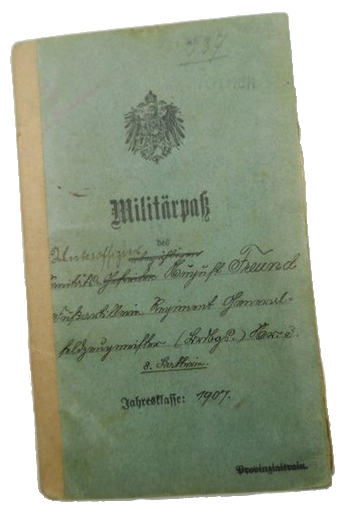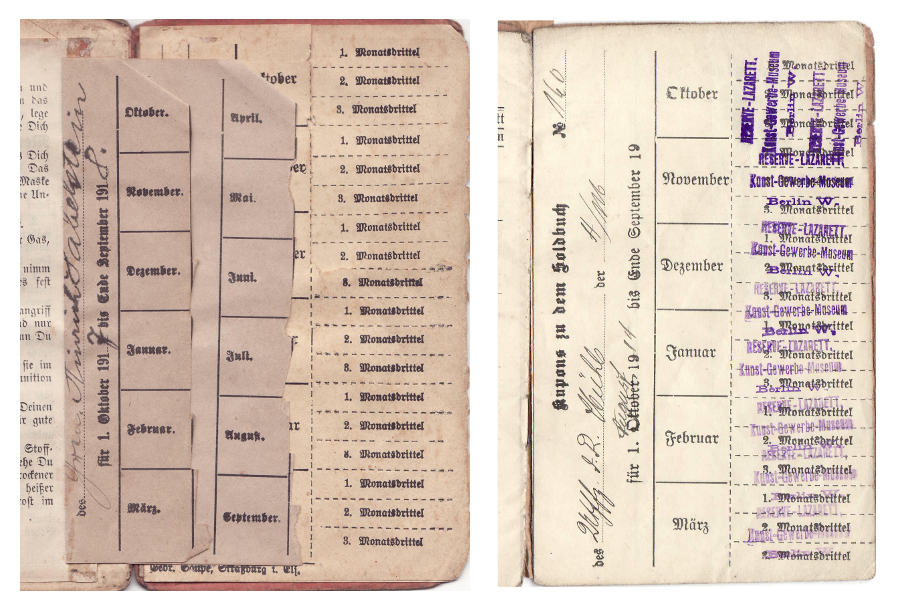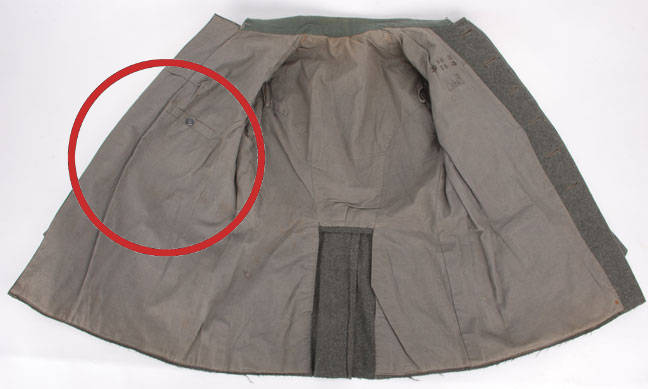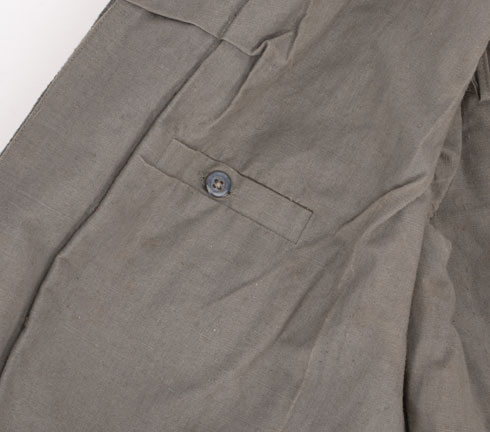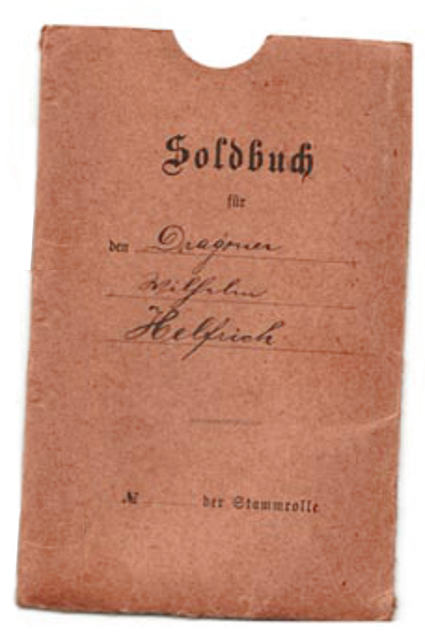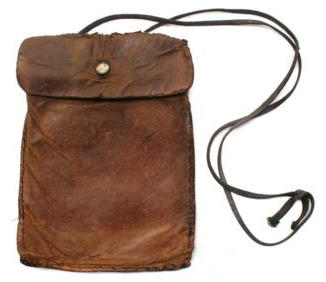Main Menu

Soldbuch
Original Militär-paß
In the years leading up to the war, all young men in Germany were obligated to serve 2-3 years in the Deutsches Heer (German Army). Upon reaching his 20th birthday (the age of elligibility dropped as the war progressed), all young men eligible for service registered and received a Militär-paß - in this small booklet was entered all of his vital information. When he was called up for service, he would turn in his Militär-paß and would receive his Soldbuch - his pay book that he would from then on always have with him.
The Soldbuch was more than just a pay book — it was nearly a complete record of the owner's military service. All of his vital statistics (age, height, weight, home address, occupation, etc.) would be entered, as well as family details (parents' names, addresses, occupations, wife, children, etc.). His innoculation and medical history, wounds, and other medical treatments (such as contracting illnesses and venereal diseases) would also be recorded. Soldiers were responsible for the upkeep and maintenance of their uniforms and gear, so everything the solider was issued was recorded. Awards, transfers, demotions, just about anything that happened to him would be recorded and this would continue until he was discharged. At that time, all the information contained in his Soldbuch would be transcribed into his permanent military record and also into his Militär-paß — he would then take his Militär-paß home to keep as his own record of his military service. The Soldbuch was then supposed to be destroyed.
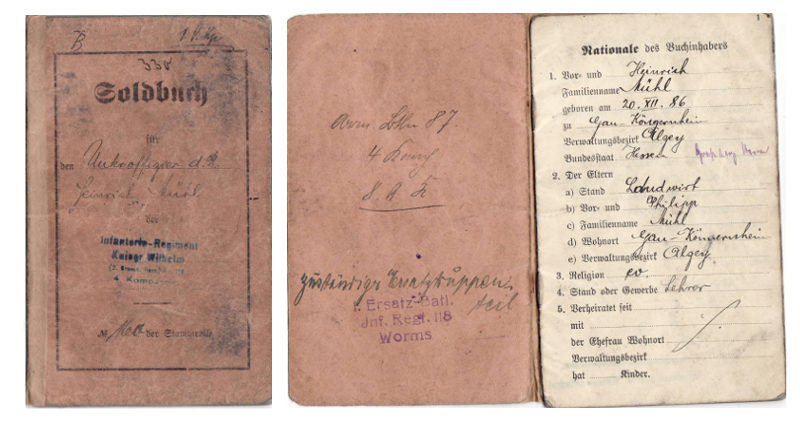
Original Soldbuch. The outside of the cover would be stamped with the unit the soldier trained with, and subsequent units would continue to be added beneath until there was no more room and then the entries would continue on the inside cover - and if they again ran out of space, a page would then be glued onto the inside face for the additional entries. The first page of the book (as seen to the right) would contain the soldier's name, birthdate and birthplace, occupation, marital status and if he had any children.
Original Soldbuch at left with pay coupons torn out, the example at right with pay coupons stamped.
The title Soldbuch is somewhat misleading, rather the book gave the soldier the authority to draw pay, in fact the original intent of the document was to allow people to draw pay from a unit other than their own. In the back of the book pages were glued in that had coupons for each date the soldier was to receive pay. When the paymaster issued the payment, the coupons were either torn out, or stamped to record the payment.
Original M.1915 Bluse, the Soldbuch pocket is circled in red.
The Soldbuch was to be carried at all times, the soldier's tunic even had a pocket specifically for the purpose. Soldiers were also know to carry their Soldbücher in wallets that were suspended around their neck. Protecting and properly maintaining the Soldbuch was not only expected, but was considered a matter of honor — the loss or willful destruction of the Soldbuch, or altering or creating false information contained in the Soldbuch, could result in penalties that might range from fines to imprisonment.
Original Soldbuch sleeve.
When stopped or questioned by the Army, Military Police or a superior officer, this was the document that the soldier would be required to show. It would not escape the inquirer's eye if the equipment and decorations that the soldier had, did not match those inscribed in his Soldbuch. All branches of the army issued Soldbücher.
Original leather wallet with
neck cord.
There was no single pattern Soldbuch — there were subtle differences from region to region and even between publishers, and as the war progessed information was added, altered and deleated, but the basic layout appears to be similar accross all the varying versions. Soldbücher were constructed with a card stock cover, the color is believed to indicate branch of service, Infantry was most often brown or reddish brown. Soldbücher were also issued with a matching carboard sleeve - these however did not typically last long, with all the papers usually stuffed inside the books, the sleeves were under a lot of stress and received a lot of wear an tear. Therefore, soldiers would buy a wallet, typically of leather or oilcloth (to provide some protection from moisture) to store and protect the Soldbuch.
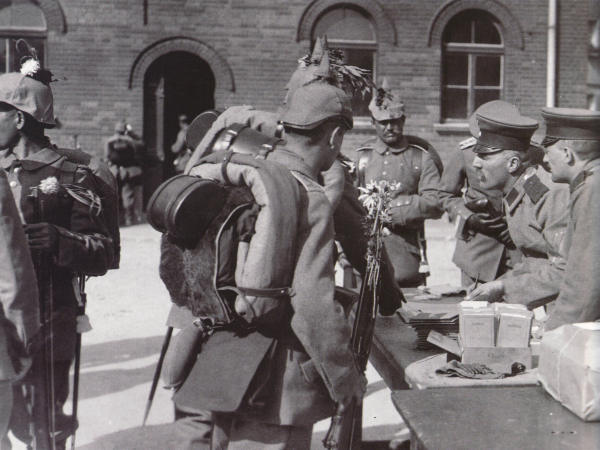
Photo from The German Army
in the First World War: Uniforms and Equipment, 1914-1918
by Jurgen Kraus for the Bayerisches Armeemuseum.
Original photo from early in the war of soldiers receiving their Soldbücher.
